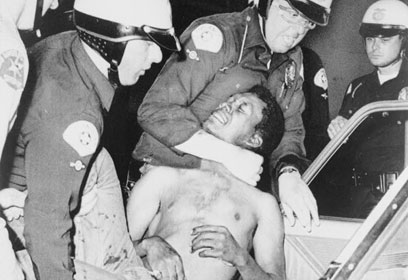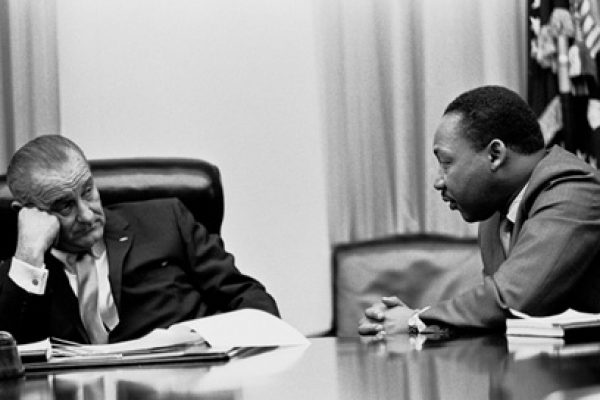Editors’ Note: This is the second part of an ongoing discussion about the significance of the Kerner report and the urban uprisings of the 1960s. The first installment, which introduces the Kerner report, is Julian E. Zelizer’s “Fifty Years Ago, the Government Said Black Lives Matter.” The last installment is Elizabeth Hinton’s “From ‘War on Crime’ to War on the Black Community.”
In recent years, police wrongdoing, racial inequality, and black rebellion in cities have seized the nation’s attention in ways that echo the response to the riots of the mid- to late 1960s. Without doubt, it is an apt time for Princeton University Press to reissue the Kerner report. Produced by the National Advisory Commission on Civil Disorders appointed by President Lyndon Johnson in 1967, the report diagnosed the cause of massive uprisings in dozens of cities and towns across the nation, from Tampa, Florida, to Milwaukee, Wisconsin. The commission also made recommendations for how to prevent such uprisings from happening again.
The most significant problem with the report is not how it characterized the uprisings, but rather its assumption that African American rioters were the main source of violence and disorder in American society.
The Kerner report concluded that rioters were not a small group of criminal “riff-raff,” as the 1965 McCone report on the Watts riots had suggested. On the contrary, rioters expressed widespread community grievances, and were generally better educated and more politically involved than neighbors who stayed home. The Kerner report also dismissed the common misperception that a radical conspiracy had organized the uprisings, something two-thirds of white Americans believed and President Johnson privately entertained as a possibility.
The report was 1960s liberalism at its best. As Zelizer makes clear, it called for a significant social investment in employment, education, and housing. Although the commission’s proposals were a far cry from the $100 billion Freedom Budget advocated by civil rights leaders, designed to provide economic justice for all Americans, they vastly improved upon Johnson’s War on Poverty.
Yet romanticizing any relic of 1960s liberalism is perilous. Malcolm McLaughlin highlights many of the Kerner report’s shortcomings in his excellent recent book on the 1967 riots, The Long, Hot Summer. Despite bold language about white racism, the report offered little precise analysis of how whites oppressed blacks. It was tone deaf about Black Power—which it portrayed as subversive and anti-American—and demands for black political autonomy. By defining the problem in racial terms, the report minimized class divisions and overlooked inequalities generated by capitalism. The report lamely suggested that better communication between government officials, the media, and African American citizens could substitute for a basic restructuring of power relations. One subsection’s heading referred to this as “A Failure to Communicate.” (Commissioners must have missed one of the year’s best films, Cool Hand Luke, in which an authoritarian prison warden famously announces, “What we’ve got here is a failure to communicate.”)
Radicals mainly criticized the Kerner report for portraying “riots” as spontaneous outbursts arising from underlying social conditions, rather than “rebellions” against injustice—in other words, as a form of political speech. The report accepted as commonsense that riots were a politically illegitimate form of violence and a basic threat to social order. However, the most significant problem with the Kerner report’s analysis, and one overlooked by Zelizer, is not how it characterized the uprisings of 1967. It is its assumption that African American rioters were the main source of violence and disorder in American society. The report denounced white segregationists and Black Power leaders alike for creating a “climate of violence” that fed the riots. But it ignored the violence of the center, the violence of the state.
You would never know from the report that at the very moment it was published, more than half a million American soldiers had been ordered to Vietnam to wage a brutal and unnecessary war. The commission was virtually banned from considering the war; Johnson forbade anyone with an antiwar record to be hired on its staff. But the war sucked away the federal money needed to fund the Kerner report’s proposals. It also discredited the report’s presumption about the illegitimacy of using violence to obtain political aims. In a 1967 speech at Riverside Church in New York City, Martin Luther King, Jr., recounted the hypocrisy he felt counseling nonviolence to young men in the ghettoes who “asked if our own nation wasn’t using massive doses of violence to solve its problems.” King declared he “could never again raise my voice against the violence of the oppressed in the ghettos without having first spoken clearly to the greatest purveyor of violence in the world today: my own government.” In his testimony before the Kerner Commission, King insisted that riots needed to be understood in the context of the “lawlessness” of American society as a whole. To African Americans, violations of building codes and equal employment laws and the unequal provision of social services made an everyday “mockery of the law.”
• • •
Although critical of policing methods to a degree unprecedented in a government report—including what surely must be one of the earliest critiques of stop-and-frisk—the Kerner report failed to acknowledge that the most destructive and lawless force in the riots was not rioters but police. The untold story of the uprisings was of excessive force police used in the name of suppressing disorder. Police and National Guardsmen caused nearly all deaths and injuries.
The report lamely suggested that better communication between government officials, the media, and African American citizens could substitute for a basic restructuring of power relations.
In Newark, Detroit, and many other cities, there were really two riots: one by African Americans against white property, followed by a reprisal waged by police against the black community. Police cordoned off riot areas to stop white vigilantes from entering the fray. They thus prevented the occurrence of race riots of the kind that had typified American history up to this point: spontaneous white vigilante assaults on black people and property with the cooperation or tacit approval of the authorities. But police and guardsmen themselves fulfilled the traditional vigilante role by violently exerting white racial authority.
Police fired at looters. They were paranoid about snipers, who in most cases simply did not exist. Anything that resembled gunfire triggered police to shoot indiscriminately at civilians. In one case, the lighting of a cigarette within an apartment building led a guardsman to shoot a tank-fired machine gun in the ember’s direction; a four-year-old was killed. During the Newark uprising, a family driving to dinner encountered a police roadblock. The driver panicked and quickly made a U-turn. Police fired at the vehicle; the family’s ten-year-old son was shot dead.
In short, the Kerner report neglected that police were not simply careless with black lives; they deliberately sought to punish African Americans with deadly force. Community activist Tom Hayden, whose eyewitness Rebellion in Newark (1967) preceded publication of the Kerner report, described Newark as a “military massacre.” According to the ACLU, police “seized on the initial disorders as an opportunity and pretext to perpetrate the most horrendous and widespread killing, violence, torture, and intimidation, not in response to any crime or civilian disorder, but as a violent demonstration of [African American] powerlessness.” Black business owners in Newark placed signs that read “soul brother” in their store windows to direct looters elsewhere. But that did not protect their stores from the police, who fired on a hundred of them. The mayor’s assistant later defended such actions: “It taught the Negro merchants a good lesson, which is that everyone gets hurt in a riot, despite the soul brother sign.”
In Detroit, police officers had permission to cover their nametags and other identifying features, allowing them to retaliate at will. Officers reportedly called rioters “savages.” One was heard saying, “Those black sons-of-bitches, I’m going to get me a couple of them before this is over.” In a notorious incident at the Algiers Motel, police and private security forces responded to suspected sniper fire by executing three teenage boys and torturing nine other black men and women. The only officer tried for the crimes was acquitted.
Retaliatory police violence during the riots differed only in pitch—but not in kind—from the commonplace, everyday violence that police forces carried out against urban black communities. Though the 1967 riots certainly emerged in part from underlying poverty and segregation, as the Kerner report argued, they were most especially enacted by young African Americans who used collective violence to protest patterns of police brutality in their communities.
• • •
By calling for more restrained anti-riot measures, the Kerner report may well have saved lives in 1968 and beyond. For example, the commission emphatically rejected lethal use of force against looters (which was favored by 60 percent of white Americans). The report devoted a chapter to the breakdown of the criminal justice system during the riots, which saw hundreds of unnecessary arrests, with many of the arrested held in undisclosed locations, without charge and with no way to contact relatives or lawyers. The Kerner report also discredited misconceptions about widespread sniper fire, finding most reported instances were actually indiscriminate shooting by the police and National Guard. It correctly identified “police incidents” as the most common cause of the riots. It criticized overpolicing of black neighborhoods through stop-and-frisk and other aggressive methods. It detailed how police were untrained for riot control and unprepared for the difficult roles assigned to them, which resulted in overreaction and lack of fire discipline.
The report neglected that police were not simply careless with black lives; they deliberately sought to punish African Americans with deadly force.
The report was absolutely correct when it said it was unfair to single out police for simply enforcing society’s will and that police reform could only succeed in the context of a broader assault against inequality. Yet by calling police “symbols” of “white power, white racism, and white repression,” the report downplayed the significant ways in which police were not merely symbols of a fatal problem but its agents. The report adopted a “he said, she said” approach that portrayed police brutality simply as African Americans’ “belief” or “perception.” Criticism of “overreaction” and lack of police “restraint” in the report obscured the reality of intentional police destruction of African American property and lives.
The commission deliberately chose to disregard information about police vigilantism that its own research had uncovered. Two commission investigators examined police killings and found several “flagrant” instances of police rearranging bodies to appear as if they had been involved in looting. In fact, the rejected draft of the report, “The Harvest of American Racism,” which Zelizer discusses at some length, candidly acknowledged the “lawless violence” of the police. It detailed the “breakdown of order” among the police and labeled them “one of the most reactionary and racist institutions of white society.” During the riots, it concluded, police operated “according to the same principles of crowd behavior that motivate the Negro riots” and acted out of “desire to vent individual hostilities, to re-establish police authority, and avenge police honor.” The only way to achieve racial justice in American cities, the draft’s authors concluded, was for federal authorities to “take sides” against metropolitan governments and police forces. But the draft’s conclusions were politically unpalatable in the extreme. They undermined the commission’s stance that racial injustice could be addressed without major overhaul of the nation’s institutions simply by enlarging social welfare programs in the same vein as Johnson’s Great Society.
Despite its shortcomings, however, the Kerner report vastly improved on what most white Americans thought they knew about the uprisings. Today, when it has become all too common to criticize those in the center-left for having “built prison America” (to quote the subtitle of Naomi Murakawa’s recent book), the Kerner report stands as a testament to the genuine concern in late-’60s liberalism for civil liberties and the reduction of inequality. But it was unrealistic to expect a government commission and the elites who populated it to recognize the systemic connections between police violence, racism, and class inequality. Then as now, it is up to those outside the system to provide that kind of knowledge.








